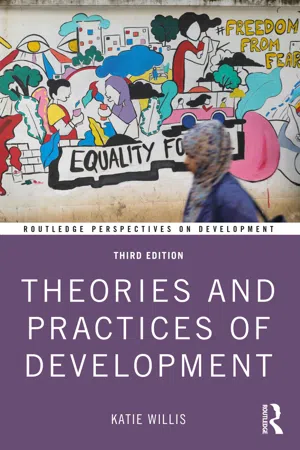
- 274 pages
- English
- ePUB (mobile friendly)
- Available on iOS & Android
Theories and Practices of Development
About this book
The newly updated third edition provides a clear and user-friendly introduction to the complex debates around how development has been understood and achieved. It has been fully updated and expanded to reflect global political and economic shifts, as well as new approaches to development.
The book deals with the evolution of development ideas and policies, focusing on economic, political, social, environmental and spatial dimensions. It highlights how development cannot be considered as a neutral concept, but is entwined with inequalities in power at local as well as national and global scales. A new chapter on politics and development presents debates around development and democracy, civil society organizations and human rights. Sections on diversity and development have been expanded, and the book considers the future of development in the era of the Sustainable Development Goals (SDGs). The use of boxed examples, tables and illustrations helps students understand complex theoretical ideas and also demonstrates how development theories are put into practice in the real world. Each chapter ends with a summary section, discussion topics, suggestions for further reading and website resources.
This key text provides a clear and thorough explanation of key development theories and practices. The third edition will remain an invaluable resource for undergraduate students in geography, politics and development studies.
Frequently asked questions
- Essential is ideal for learners and professionals who enjoy exploring a wide range of subjects. Access the Essential Library with 800,000+ trusted titles and best-sellers across business, personal growth, and the humanities. Includes unlimited reading time and Standard Read Aloud voice.
- Complete: Perfect for advanced learners and researchers needing full, unrestricted access. Unlock 1.4M+ books across hundreds of subjects, including academic and specialized titles. The Complete Plan also includes advanced features like Premium Read Aloud and Research Assistant.
Please note we cannot support devices running on iOS 13 and Android 7 or earlier. Learn more about using the app.
Information
chapter 1
Meanings of development
- Definitions of development
- Measuring development
- Colonialism
- Globalization and development
- Development actors
- Postcolonialism, Postmodernism, Post-development
Box 1.1 Sustainable development goals
- 1End poverty in all its forms everywhere
- 2End hunger, achieve food security and improved nutrition and promote sustainable agriculture
- 3Ensure healthy lives and promote well-being for all at all ages
- 4Ensure inclusive and quality education for all and promote lifelong learning
- 5Achieve gender equality and empower all women and girls
- 6Ensure access to water and sanitation for all
- 7Ensure access to affordable, reliable, sustainable and modern energy for all
- 8Promote inclusive and sustainable economic growth, employment and decent work for all
- 9Build resilient infrastructure, promote sustainable industrialization and foster innovation
- 10Reduce inequality within and among countries
- 11Make cities inclusive, safe, resilient and sustainable
- 12Ensure sustainable consumption and production patterns
- 13Take urgent action to combat climate change and its impacts
- 14Conserve and sustainably use the oceans, seas and marine resources
- 15Sustainably manage forests, combat desertification, halt and reverse land degradation, halt biodiversity loss
- 16Promote just, peaceful and inclusive societies
- 17Revitalize the global partnership for sustainable development
- SDG 1.1: By 2030, eradicate extreme poverty for all people everywhere currently measured as living on less than US$1.25 per day.
- SDG 3.3: By 2030, end the epidemics of AIDS, tuberculosis, malaria and neglected tropical diseases and combat hepatitis, water-borne diseases and other communicable diseases
- SDG 8.1: Sustain per capita economic growth in accordance with national circumstances and, in particular, at least 7% gross domestic product growth per annum in the least developed countries
Modernity
Development as an economic process
Table of contents
- Cover
- Half Title
- Series
- Title
- Copyright
- Contents
- List of plates
- List of figures
- List of tables
- List of boxes
- Acknowledgements
- List of acronyms
- 1 Meanings of development
- 2 Modernization, Keynesianism and neoliberalism
- 3 Structuralism, neo-Marxism and socialism
- 4 Politics and development
- 5 Grassroots development
- 6 Social and cultural dimensions of development
- 7 Environment and development
- 8 Conclusions
- Bibliography
- Index